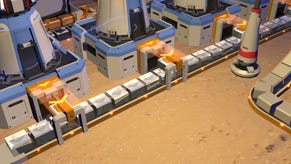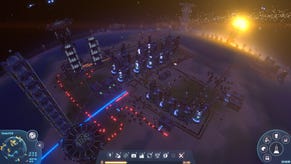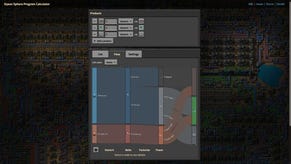Dyson Sphere Program Power and Energy: how to power your factory and your mech
Understanding Power Grids and Fuel in Dyson Sphere Program
Dyson Sphere Program is all about power. After all, your long-term goal is to create a Dyson Sphere capable of harnessing the energy of a star. But in order to do that, you'll need more modest sources of energy in order to power your colossal planet-devouring factories and production chains.
Our Dyson Sphere Program power and energy guide will help you to fully understand how power grids work in this game, along with tips on keeping your mech powered and the various fuel types you can use throughout your megastructure-constructing journey.
On this page:
- Dyson Sphere Program Power Grid explained
- How to make sure you're producing enough power
- Types of power generators
- How to power your mech
- Dyson Sphere Program Fuel Types
Dyson Sphere Program Power Grid explained
In Dyson Sphere Program, you need to harness energy of various kinds to power your factories. A power grid, at its core, is amazingly simple. All you need is:
- A building that generates power (such as a Wind Turbine);
- A building that consumes power (such as a Mining Machine);
- A building that connects the generators to the consumers (such as a Tesla Tower);
- (Optional) A building that stores energy (such as an Accumulator).
Every power-generating building (like Wind Turbines), and every range-extender (like Tesla Towers) produce a circle of "energy" around them. A building is considered "powered" if its central tile is covered by one of these circles. It's best to build big blocks of power generators away from your production buildings, and then connecting one to the other with lines of Tesla Towers.
How to make sure you're producing enough power
It's very important to keep an eye on your power grid satisfaction levels. You can check whether you're producing enough power by clicking on a Tesla Tower or an energy-generating building within the grid. You'll see real-time statistics on the amount of power generated and consumed within the grid.
If the percentage value inside the circle is below 100%, then you're not producing enough power to meet demands, and all the buildings that draw power from that grid will start to slow down, leading to all sorts of problems. Another quick way to check satisfaction levels is to turn on the power overlay by tapping "H" to bring up the Details Display, and clicking the power grid button. This will allow you to see all the energy circles of every building. If groups of circles are turning (or blinking) orange, then power generation is not meeting demand in that area.
In a nutshell, click on a Tesla Tower every so often and make sure that percentage number is at 100%. If it isn't, you need more power generators.

Types of Power Generators
There are a few different types of power-generating buildings in Dyson Sphere Program. You'll unlock them in roughly this order, and each is more costly to produce than the last:
- Wind Turbine (Generates max 300kW but scales with the Wind Energy Ratio of each planet)
- Thermal Power Station (Generates 2.16MW but needs to burn fuel constantly)
- Solar Panel (Generates max 360kW but only works while the sun is shining on it. Scales with the Solar Energy Ratio of each planet)
- Ray Receiver (Generates max 5MW, requires partial or complete Dyson Swarm or Dyson Sphere. Only works while in view of the Swarm/Sphere)
- Artificial Star (Generates 75MW. Really fucking expensive)
How to power your mech
In a departure from similar factory-building games, in Dyson Sphere Program your character - your mech, Icarus - must be powered continuously by burning fuel in its fuel chamber. You can see your mech's current charge level at the very bottom-centre of your screen. Hover over the arrows that appear to view detailed information on what's charging or draining your mech's power at any given time.
Almost any activity your mech undertakes will consume energy, from moving to fabricating to sending out drones to construct buildings. Your mech will generate a small amount of power by itself, but that won't be enough to keep your mech fully powered, so you'll need to burn fuel. Bring up your Fuel Chamber by tapping "C". From there you can take fuel from your inventory and drop it into your Fuel Chamber to keep your mech powered for a while.
Different fuel types will generate energy faster and keep you fuelled for longer, as you'll see below.
Dyson Sphere Program Fuel Types
There are a fair few different fuel types in Dyson Sphere Program, some more effective than others. Below you can see the energy produced by burning each one, along with the Fuel Chamber Generation value (FCG), which is an indicator of how quickly the fuel will convert to energy inside your mech. Almost all of these fuel types can also be burned inside a Thermal Power Station.
| Fuel Type | Energy | FCG |
|---|---|---|
| Plant Fuel | 500 kJ | -30% |
| Log | 1.5 MJ | -10% |
| Organic Crystal | 1.8 MJ | -20% |
| Coal | 2.7 MJ | 0% |
| Energetic Graphite | 6.3 MJ | +60% |
| Crude Oil | 4 MJ | +20% |
| Refined Oil | 4.4 MJ | +30% |
| Hydrogen | 8 MJ | +100% |
| Deuterium | 8 MJ | +100% |
| Diamond | 900 kJ | -50% |
| Graphene | 96 kJ | -70% |
| Carbon Nanotube | 84 kJ | -80% |
| Fire Ice | 4.8 MJ | +40% |
| Hydrogen Fuel Rod | 40 MJ | +200% |
| Deuteron Fuel Rod | 600 MJ | +300% |
| Antimatter Fuel Rod | 7.5 GJ | +500% |
| Full Accumulator | 90 MJ | +100% |
Until you reach the end-game of Dyson Sphere Program, the best fuel to burn in your mech is Energetic Graphite. Hydrogen is technically even better in terms of energy and speed, but Hydrogen only stacks up to 20, compared with Graphite's 100, which means you'll need to return and restock Hydrogen much more frequently than if you just used Graphite.
And with that, I'll wrap up this introduction to energy grids, fuel types, and power in Dyson Sphere Program. If you're interested in learning more about the game, be sure to check out our Dyson Sphere Program guide to getting set up in under an hour, as well as our more general Dyson Sphere Program tips page.










